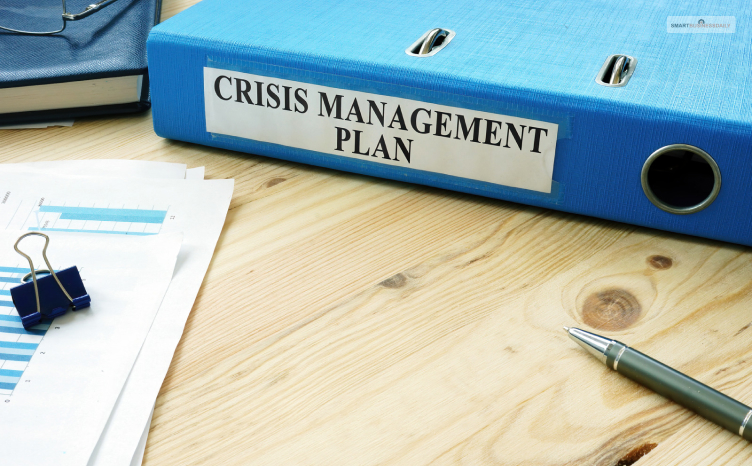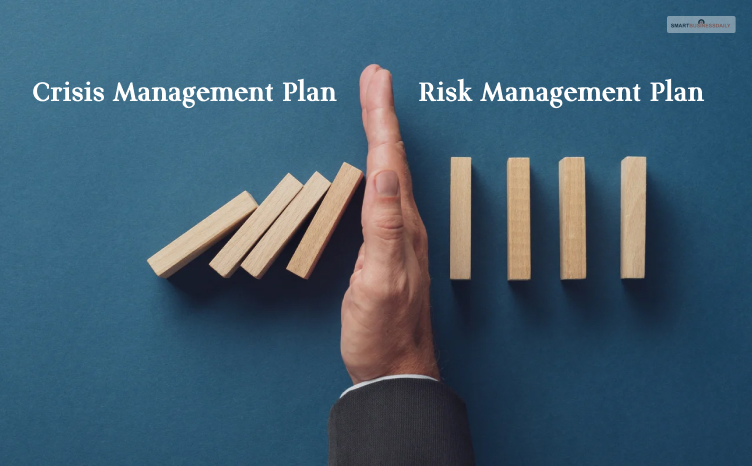Why Should You Have A Crisis Management Plan? Will It Save You?
7 Mins Read
Published on: 30 July 2024
Last Updated on: 09 November 2024

- What Is A Crisis Management Plan?
- Why Do You Need A Crisis Management Plan?
- What Is The Purpose Of A Crisis Management Plan?
- Crisis Management Plan Vs. Risk Management Plan
- General Elements That You Need To Include
- Step-By-Step Rundown Of Crisis Management Plan
- Step #1
- Step #2
- Step #3
- Step #4
- Step #5
- The Final Thought
Imagine you are on your rapid growth arc. However, it all comes to a screeching halt. A crisis just hit your business, and you struggle to get around it. It would help to have a crisis management plan to get out of this fix.
A crisis management plan is more than just a means to ‘undo’ damage. It can save corporations from going under or dwindling into nothingness. Therefore, if you are a business enthusiast or an entrepreneur, you might want to stick around and learn more about crisis management strategies.
Let’s go!
What Is A Crisis Management Plan?

Nobody wants to face a crisis. Every entrepreneur you meet would implore you to avoid them at all costs. However, it is inevitable. That means your business would, at some point, experience crises. It could be financial, organizational, political, etc.
Therefore, the only smart thing to do is to learn crisis management skills to avoid it. However, this is a challenging task. There is no set path to solving a crisis. It is all about trial and error. Also, crises can come in different shapes and sizes. Therefore, having a set plan will help you in the long run.
A crisis management plan, or CMP, is a pre-emptive plan meant to contain or help a business resume operations. Therefore, the term is best defined as a practice of trying to solve a crisis or at least attempting to include it.
Why Do You Need A Crisis Management Plan?
Crisis management is an essential aspect of today’s business landscape. Technological advancement has influenced and fast-forwarded the development cycle for decades. However, it has also made institutions more susceptible to crises.
Therefore, having a clear set of crisis management plans is crucial, to say the least. Otherwise, even big companies like Nokia could undergo significant changes or end up going bankrupt.
Crisis Management usually tackles priority areas and tries to contain the problem. This is a crucial step in crisis management planning. Subsequently, having regular drills will also hone the responsible team’s skills and make them better suited for the challenges that they might face.
Therefore, crisis management strategies are most important because they keep you in the loop and alert.
However, it would help if you remembered that you might not be able to avoid the crisis. But you can unquestionably dampen the blow. Therefore, crisis management consulting and planning is seminal to save the respective business and bring it back on track.
All in all, having crisis plans and management modules in place will also enable you to mitigate issues like organizational problems, financial blows, etc. Even if your company is growing fine, you still need one strategy for the rainy day.
What Is The Purpose Of A Crisis Management Plan?

Having a proper crisis management plan is very important. It has several benefits. However, it would help if you always remembered the real purpose of a crisis management plan.
In simplest terms, crisis management plans give organizations an edge or the capability to fight back. Here are two of the most essential and prominent purposes that crisis management plans play in the long run:
- Crisis Management Plans make companies more resilient to small as well as medium threats. In other words, it keeps the short- and long-term effects at bay. Therefore, crisis management improves the overall standing of a company.
- The second purpose of this program is to help create a more prepared atmosphere of work. In other words, it allows the company to foresee things that might or will go wrong.
Crisis Management Plan Vs. Risk Management Plan

Crisis management often needs to be clarified with risk management. This is because both concepts have some significant similarities. However, both of these concepts share similarities but are different.
Crisis management refers to the plan of action an organization follows if and when a crisis arrives. This plan was formulated ahead of time but was adjusted according to the crisis that came. This is a reactionary plan that tries to contain the crisis or resume the business operation effectively.
Meanwhile, a risk management plan is a pre-emptive action plan. Risk management plans allow companies to avoid problems. However, it deals with predictive data. This means.,risk management strategies are all about predicting a problem.
Risk management and crisis management are two parts of the same coin. They work hand in hand. However, they are not similar. They are two very different concepts that might work closely but differ in some fundamental areas.
General Elements That You Need To Include

Formulating a crisis management plan is not just about adopting technology to assess risks or studying market trends over several years. It is a highly complex problem that consists of several smaller cogs.
you can only formulate effective crisis communication strategies by understanding all the general elements. Here are some fundamental elements that make up a crisis management plan.
- Risk Analysis: This is the foremost aspect of crisis management. You can only get ahead of things if you start analyzing the risks. A plan with this crucial element is a good plan per se.
- Activation Protocol: Put in place multiple crisis management plans. Having multiple plans is very important because you never know which might work and which won’t.
- Chain of Command: Having a defined chain of command during crisis management is also an important aspect. During times of crisis, employees must know who they have to report to. Otherwise, things may be chaotic.
- Command Center: During a crisis, you must remember your base of operations. This enables more prompt responses to problems.
- Response Action Plans: A crisis management plan is a reactionary plan. Therefore, it is essential to have a clear response action plan. A response action plan includes all the points that you need to understand and work on. This is like the holy grail of a crisis management plan.
These elements make up the concept of crisis management plans. Therefore, they play a vital role in the long run.
Step-By-Step Rundown Of Crisis Management Plan

No one-size-fits-all crisis management plan can deal with different types of crisis management situations. Therefore, you must not expect that you could tackle any and every challenge with that one master plan.
With that out of the way, here are some of the most prominent means or steps you can follow to formulate a crisis management plan for your company.
Step #1
The first thing that you need to do is to understand the nature of the risks. You might be facing one crisis or multiple crises at the same time. Therefore, you must have a clear understanding of the nature of the situation that is coming because different crises demand different approaches.
Hence, wait to go to the drawing board. Take your time assessing and studying. This would enable you to take effective pre-emptive measures. Therefore, the first thing you need to do is understand the nature of the threat.
Step #2
The next step is to decide on the crisis management team. A program is as good as the team heading it. Therefore, an internal team should be created capable of handling these problems.
Be very careful about who you pick for the team. We suggest you go for people with expertise in handling challenges or crises. Therefore, only go for experienced employees. Crises are solved with expertise.
Step #3
The third step is to create or formulate optimal responses. The first 24 hours of a crisis is critical. Try to keep the team ready to start their work at a moment’s notice. This is one of the most crucial aspects of a crisis management plan.
The best practice is to formulate multiple responses and not just one single response. One single response might not be suited to tackle a multi-pronged crisis. Therefore, there should be plans that can be switched or plans that are suitable to tackle multiple different forms of crises.
Step #4
Social media is a crucial tool to have at your disposal. Given how businesses have moved from the real world to a more virtual setting, maintaining and updating social media is very important.
As soon as you hit the crisis point, tell your social media team to formulate a post informing clients and customers. This would add a sense of transparency. Something that your customers and clients would appreciate.
Step #5
The final step is to start working on the plan. Once you are done assessing, structuring a crisis management plan, and informing stakeholders, you should start working towards containing the crisis.
Keep a timeline in your head and start working. Try to get everything up and running before the timeline. This would greatly help you and your business.
The Final Thought
In summation, that is what you need to do to formulate the perfect crisis management plan. However, you must remember that crisis management is a reactionary measure. Therefore, do not go in with the expectation to ‘undo’ the damage. If the damage is extensive, you cannot do anything. You can only hope and pray. Keep following our page for more such content.
Read More…



















Comments Are Closed For This Article